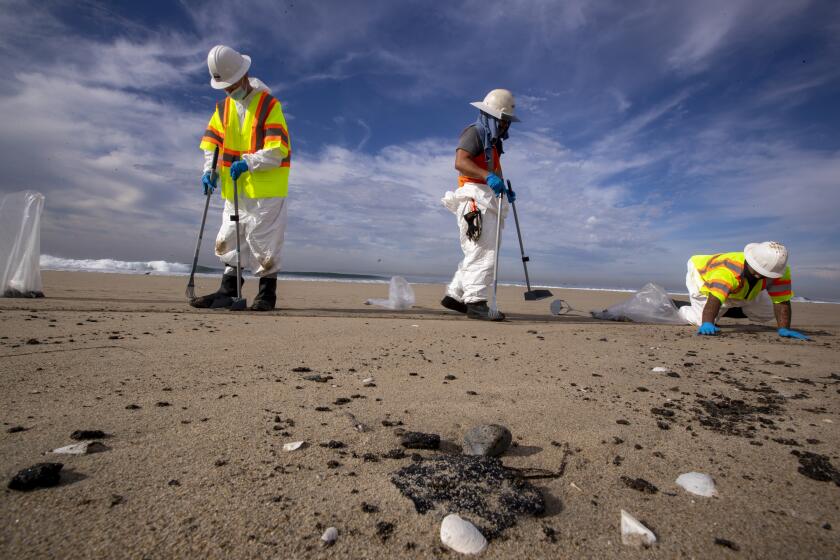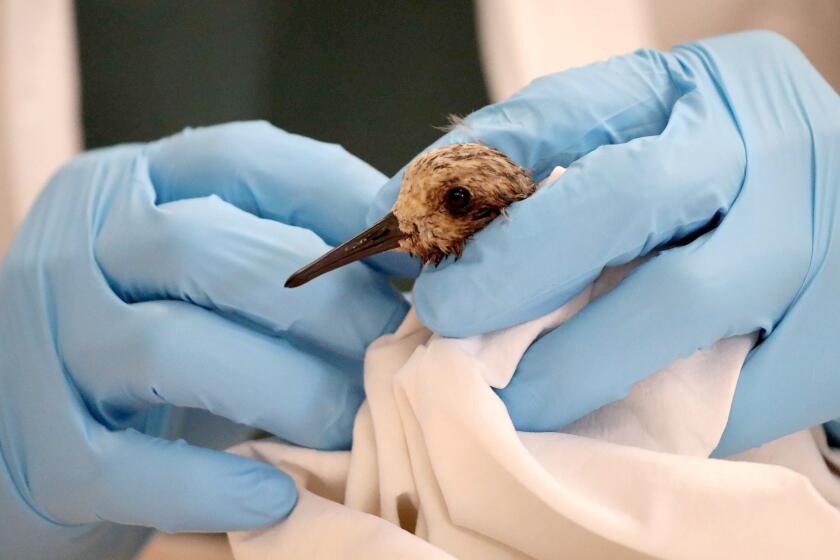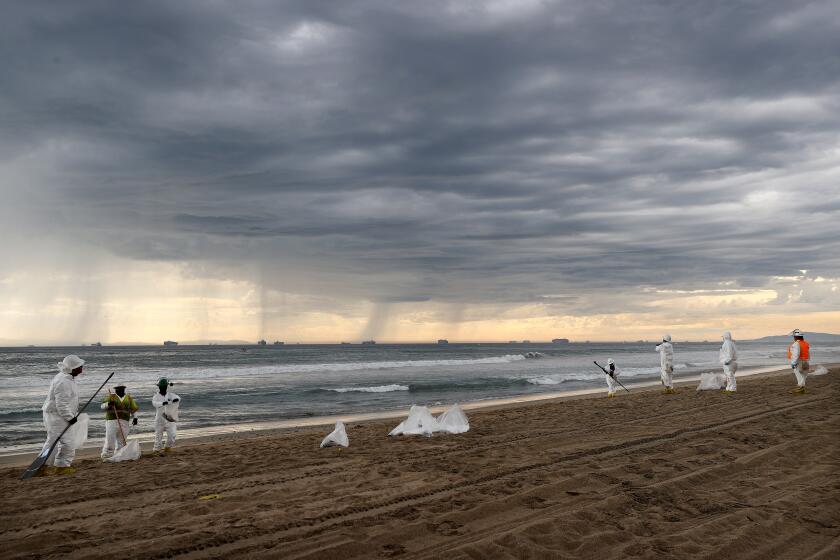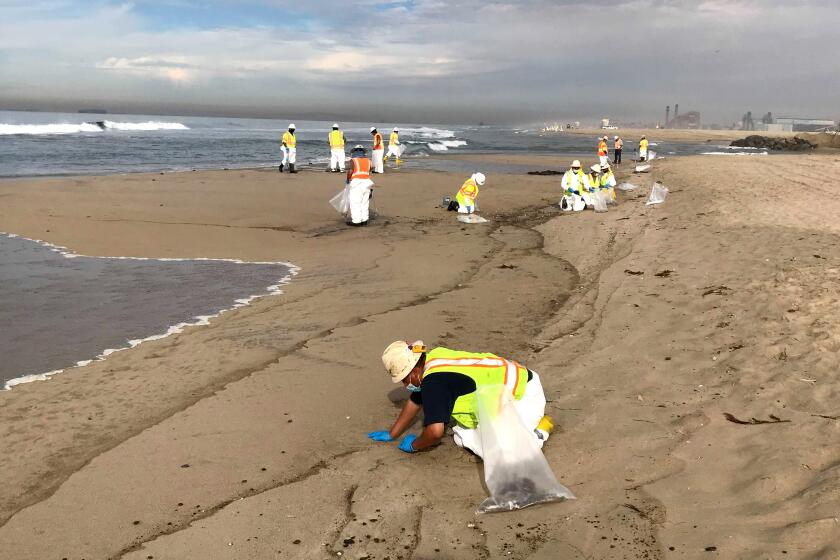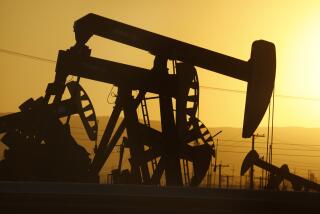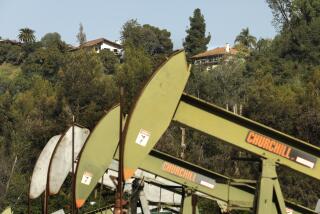Federal regulation of oil platforms dogged by problems long before O.C. spill
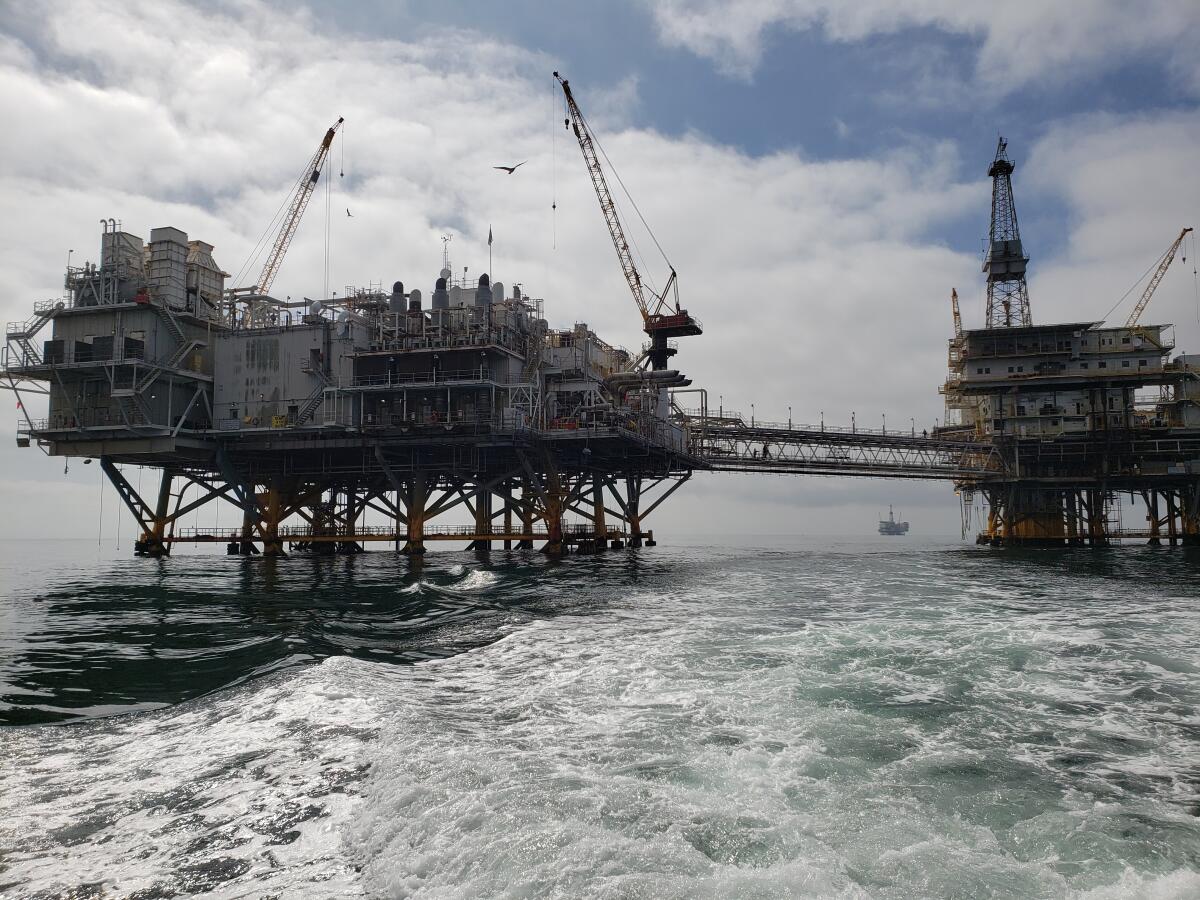
- Share via
Government regulators have long failed to effectively oversee energy companies that rely on pipelines to transport large volumes of oil from offshore rigs, according to experts, environmental advocates and even reports by a federal watchdog agency.
Regulators admitted that inspection requirements for pipelines like the one that ruptured off the coast of Orange County in recent days are inadequate, records show, and environmentalists complain that federal authorities rely too heavily on oil companies to conduct their own checks of their infrastructure.
Federal overseers are short-staffed and have failed to update regulations that are in some cases decades old, falling behind technological advances in the industry, environmentalists and industry experts said.
Following the devastating Refugio oil spill off the Santa Barbara coast in 2015, Miyoko Sakashita of the Center for Biological Diversity co-signed a letter from the organization petitioning the two federal agencies responsible for overseeing underwater pipelines to adopt an aggressive inspection program and stop relying on oil companies to conduct their own inspections. But the demand went nowhere.
“The system is flawed,” she said Tuesday, “and there is inadequate oversight of these platforms.”
It is unclear whether federal regulators could have done anything to help prevent the massive pipeline leak that poured up to 144,000 gallons of oil into the waters off Orange County. A preliminary report suggests that a ship’s anchor might have ruptured the pipeline.
But whatever the cause turns out to be, several environmentalists and former industry officials said investigators should scrutinize whether the two federal oversight agencies were providing adequate oversight of the pipeline. Those are the U.S. Department of Transportation’s Pipeline and Hazardous Materials Safety Administration and the U.S. Department of the Interior’s Bureau of Safety and Environmental Enforcement — an agency that was created in the wake of the 2010 Deepwater Horizon disaster, in which 11 workers were killed and 4 million barrels of oil spewed into the Gulf of Mexico.
Bobby Nash, a spokesman for the bureau, said in a statement emailed to The Times on Tuesday that the ruptured pipeline was last inspected by the company that operates it in October 2019. Under a January 1999 agreement between the two federal oversight agencies and state authorities, the company, Houston-based Amplify Energy, “is required to conduct an internal inspection of the pipeline every two years,” he said.
“BSEE also conducts annual comprehensive inspections, and unannounced inspections of all platforms in federal waters offshore California every two months,” Nash said. He did not say whether the required agency-initiated inspections of Amplify’s pipeline had been completed in recent years.
Critics in both the public and private sectors have been particularly harsh in their assessment of what they see as BSEE’s failures to act as a robust regulative authority.
In March, the nonpartisan Government Accountability Office released a report criticizing BSEE’s oversight of pipelines. BSEE officials acknowledged that their requirements are inadequate in spotting leaks, according to the report.
“BSEE has long recognized the need to update its pipeline regulations to better ensure pipeline integrity,” the report said, adding elsewhere that according “to BSEE, the bureau’s regulations are outdated and do not address how pipelines should be inspected, the complexities of deep water pipeline operations, and changes in technological standards.”
The class-action lawsuit filed in Los Angeles Monday alleges lost wages and potential exposure to health hazards.
The regulatory lapses have had consequences. In 2016 and 2017, two pipeline ruptures resulted in a combined 18,000 barrels of spilled oil, and agency officials believed the leaks should have been caught sooner, according to the GAO report.
In response to those spills, the report said, the agency considered reforms but officials felt they could not “compel industry to take any action to detect leaks that is not described in its regulations.”
Frank Rusco, director of the GAO’s natural resources and environment team, said the pipeline regulations overseen by BSEE were first written in 1988 and much has since changed in the industry. Operators have drilled in deeper waters, and the code hasn’t kept up with the changing technology.
The agency also hasn’t studied what kind of infrastructure should be required in different environments to determine what is needed to detect leaks the fastest and prevent damage to pipelines.
“BSEE cannot point to a document that says this is how we manage our part of ensuring that these pipelines are safe and sound,” Rusco said.
GAO officials said BSEE’s jurisdiction needs to be more defined and that expanding BSEE’s role is under consideration. That could help clear up areas of overlap with PHMSA.
A developing list of what Southern Californians can do to help with the O.C. oil spill.
Last year, the two federal agencies signed an agreement to improve their oversight of underwater pipelines and to coordinate their response to incidents such as oil spills by sharing responsibilities based on pipelines’ locations.
PHMSA officials could not be reached for comment. The BSEE did not respond to a Times request to review records that would show how it has regulated Amplify’s decades-old equipment in recent years.
Maggie Hall, senior attorney for the Environmental Defense Center, a nonprofit environmental law firm that was created in response to the 1969 Santa Barbara oil spill, said there’s a long history of insufficient transparency and federal oversight when it comes to offshore operations in California.
“There is a disconnect between the responsible agencies’ duties to make sure these things are safely happening — and the reality,” she said.
She and other experts said this situation in which much of the oil drilling and transportation infrastructure is aging and loosely regulated by the government has created the perfect environment for disasters like the current oil spill in Orange County.
Robert Bea, a UC Berkeley professor emeritus of engineering and project management and systems, worked for years in the offshore oil industry, first as a roughneck on an oil platform in the Gulf of Mexico for Shell Oil and ultimately as director of Shell Oil’s offshore design group in New Orleans.
At a news conference focused on the oil spill, the California governor made a point about the need to shift away from oil industry-based jobs. “It’s time once and for all to disabuse ourselves that this has to be part of our future,” Newsom said of drilling. “This is part of our past.”
Over four decades ago, Bea helped design platform Elly — the Amplify-owned rig off the coast of Huntington Beach to which the 41-year-old pipeline believed to have been the source of the oil spill is connected — focusing on structural safety and operational components. He said that Elly is old and is operating past its operational life and should be decommissioned, and that age has also taken a toll on the attached pipeline, which transports oil from Elly to the Port of Long Beach.
“It’s not safe,” he said of Elly, adding that the “pipeline is aging and expecting it to perk along like it’s new is an idiot’s game.”
He added that BSEE does not have enough investigators to effectively inspect offshore facilities and has failed to keep up with the technological advances in the industry.
“They don’t have the money and they don’t have the knowledge,” Bea said of the federal agency and its investigative arm. The bureau, he contended, “is in a very pitiful situation of not being able to regulate what needs to be regulated.”
BSEE says it has only about 130 inspectors tasked with overseeing all of America’s offshore oil facilities along the coasts of Alaska, California, Louisiana and Texas.
Meanwhile, actions taken by the Trump administration have weakened BSEE’s enforcement capacity. After the Deepwater Horizon spill in 2010, a special panel made key recommendations to prevent a similar disaster from occurring again, including tougher safety regulations on the oversight and operation of offshore oil equipment, such as undersea wells and blowout preventers.
Divers examining the 17.7-mile pipeline found it had been displaced by about 105 feet and had suffered a 13-inch split running parallel to the pipe.
Many of these new rules were adopted by BSEE in 2016, the last year of the Obama administration. By 2019 the Trump administration had rolled back a number of them, such as the requirement for companies to have a BSEE-approved independent expert verify safety measures and equipment used in offshore drilling operations.
“These were all things that the industry asked Trump to roll back,” said Richard Charter, who has worked on offshore oil issues for 40 years and is now a senior fellow at the nonprofit Ocean Foundation. “Trump took a number of actions ... to weaken BSEE’s oversight of the federal offshore drilling industry.”
Times staff writer Laura J. Nelson contributed to this report.
More to Read
Sign up for Essential California
The most important California stories and recommendations in your inbox every morning.
You may occasionally receive promotional content from the Los Angeles Times.
